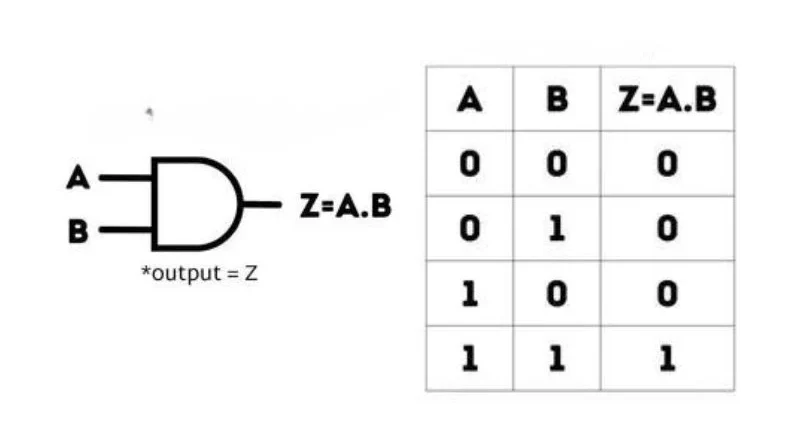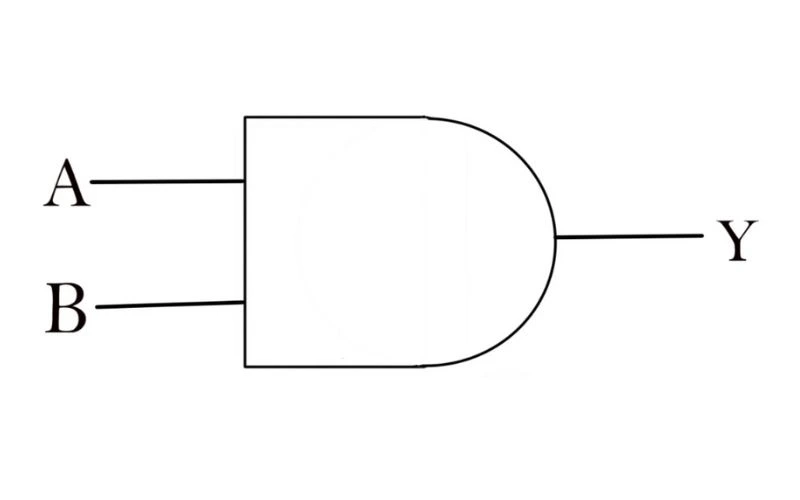
An AND gate can be considered a sentinel, standing guard in a world of electronic currents. Its role is simple but essential: it transmits high signals only when all its inputs are high. It's like a strict guard who only opens the gate when all the group members arrive. However, when a single input reaches a low level, it outputs a low signal and operates on a strict “all or nothing” code. With this understanding we began our journey through the fascinating world of digital circuits.
An AND gate is a basic digital logic gate that produces a high (1) output only when all of its inputs are high (1). It performs logical operations and is essential for building complex logic circuits for tasks such as arithmetic, data processing, and control functions in electronic devices.
Essential elements of the AND gate

The AND gate is an important electronic component in digital systems. It is responsible for generating an output with logic 1 only when all inputs are at logic level 1. In other words, each low input produces a low output. This behavior is represented by the word “AND” in its symbolic representation in a circle.
In practice, the AND gate facilitates logical operations in which several binary signals must be evaluated at the same time. This is comparable to needing all the keys to unlock a safe. Without each individual, it remains safely closed.
The truth table for an AND gate further validates how it works.
Truth table for an AND gate
| Input A | Input B | exit |
| 0 | 0 | 0 |
| 0 | 1 | 0 |
| 1 | 0 | 0 |
| 1 | 1 | 1 |
The truth table illustrates the condition that must be met for the output to become high: Only when inputs A and B are logic “1” will the output become logic “1”. Any other combination will result in low production.
Now that we have thoroughly examined the basic function of the AND gate and its operational insights, it is time to delve deeper into its central role in performing logical operations in digital systems.
Investigation of the operational dynamics of AND gates
To understand the operational dynamics of an AND gate, we can resort to the principles of Boolean algebra. This type of mathematics deals with concepts such as “true” and “false”, which form the backbone of digital logic and depend on the combination of input states.
When we talk about “input states,” we mean two specific signals: A and B. These signals can be “true” (or “1” in binary) or “false” (0). The AND gate works in a unique way, producing a “true” output only when A and B are “true”.
To illustrate, let's break this down into a simple table:
| Input A | Input B | Q output |
| 0 | 0 | 0 |
| 0 | 1 | 0 |
| 1 | 0 | 0 |
| 1 | 1 | 1 |
In summary, using Boolean algebra, if A or B (or both) are in the “wrong” state, the output will also be in the “wrong” state. Only when A and B are in the “true” state does the AND gate produce a “true” output.
This strict condition for output generation highlights the importance of AND gates in digital circuits, especially in logical decision-making processes. They mimic our daily if-then thought process – if both conditions are met, then take action. This simple logic forms the basis for more complex calculations and decision-making processes in electronic devices and systems.
Understanding these operational dynamics provides insights into the contribution of AND gates to the accuracy and reliability of digital circuits and provides valuable information about their role in logic operations.
Having examined the operational dynamics of AND gates, we can now delve deeper into their role in electronic circuits.
Electronic circuits and the role of the AND gate
Think of the AND gate as a sentry – it stands guard at the entrance to a digital circuit, granting entry only to the select few who meet its strict criteria. Semiconductor devices like transistors and diodes, which form the building blocks of modern technology, achieve this through the magic of orchestrating complex operations quickly and accurately.
Transistors play an important role in electronic circuits. Connecting transistors in series across an AND gate is similar to a relay race where each runner must keep moving forward to pass the baton. Likewise, the AND gate inputs must be “on” to produce an output. Think of it like a traffic light: all lights must be green for the car (or entry signal) to keep moving. If a signal remains red (i.e. logic level “0”), it will not advance. This signal multiplication in the AND gate illustrates its true purpose – to perform a logical “and” operation. Simply put, both input signals must be active for the output signal to reflect their state. The gate output remains inactive if one or both inputs are inactive.
Understanding through a scenario
Consider an everyday scenario : To access your private property, someone needs a valid ID and a unique password. If any of them are missing, access will be denied. This analogy reflects the operation of an AND gate in a digital circuit, where access – symbolized by the output – is only granted if both conditions are met. This special functionality forms the basis of digital systems and microprocessors and controls their operation at all levels.
Understanding this central role allows engineers and designers to produce complex circuits with the highest precision, ensuring the seamless integration of countless complex components.
By understanding these complex semiconductor-based activities, you will be well equipped to harness the full potential of these essential electronic elements in your work.
Mastering the intricacies of AND gates serves as a springboard for their application in computer microprocessors.
Applications of AND gates in computer microprocessors

Microprocessors power everything from smartphones to supercomputers. At the core of these microprocessors, many AND gates perform critical tasks in the background, allowing the processor to perform a variety of operations accurately and quickly. This makes them indispensable for the efficient functioning of digital devices.
Expiration date
A fundamental application of AND gates in microprocessors is data validation. When the microprocessor receives data, it must verify its accuracy before proceeding with processing. This is where the AND gate comes into play. It acts as a gatekeeper, checking whether certain conditions are met before forwarding data. By using AND gates, the microprocessor ensures that it will only process valid data, which contributes to the overall reliability and integrity of the system.
Address decoding
Address decoding is another important task that depends on the functionality of AND gates in microprocessors. As part of this process, the microprocessor uses AND gates to interpret memory addresses and determine which memory location to access. This process is crucial for the proper execution of instructions and the efficient use of the digital device's memory resources.
Role in arithmetic functions
Furthermore, AND gates play an essential role in microprocessor operations in processing arithmetic functions – comparing two values, enabling certain operations based on conditions, or performing logical operations such as bitwise AND. The reliability and efficiency of AND gates are essential to ensure that microprocessors perform their tasks effectively and accurately.
When it comes to complex mathematical calculations and logical decision making, the reliability and efficiency of AND gates are essential to ensure that microprocessors perform their tasks effectively and accurately.
Microprocessor operational functionality
Essentially, AND gates form the backbone of a microprocessor's operational functionality. Its ability to process input signals and produce accurate outputs based on logical conditions is the basis for the reliable and efficient performance of modern digital devices. Without these small but powerful electronic components, our digital world could not function with such speed and precision.
Now that we understand how AND gates work in computer microprocessors, we can move on to the practical study of constructing an AND gate circuit.
Hands-On Instructions: Building an AND Gate Circuit
Building an AND gate circuit may seem complicated at first, but it becomes much easier once you take it apart. First, it is important to understand that gates are fundamental for processing binary data in digital logic. They take two input signals and produce an output signal that depends on both actual input signals. Let's take a practical approach to understand the working and implementation of AND gate circuits.
The key to building an effective AND gate circuit is choosing the right integrated circuit (IC) based on the number of input signals required. For example, with a standard IC like the 74LS08 you can easily implement a common 2-input AND gate. The internal structure of this IC is designed to perform logical operations, making it an ideal choice for creating simple AND gate circuits.
Connecting the inputs and outputs
The cathode is connected to the input conditions when configuring the IC, while the anode represents the output. This connection plays a crucial role in defining how inputs interact with each other and produce an output based on their logical combination.
For example, imagine a scenario where you want to design a circuit that turns on a light only when a motion sensor and a temperature sensor detect activity. In this case, you would use an AND gate circuit with two inputs – one from the motion sensor and one from the temperature sensor – and one output connected to the light.
This hands-on design process is critical to helping engineers understand how digital circuits perform logical operations and provides valuable insights into theoretical and practical applications.
For the AND gate circuit to work properly, you must ensure that its connections are secure and accurate. The careful approach to connecting these components serves as a practical exercise that promotes learning and understanding of the principles of digital logic.
Engineers gain a deeper understanding of their operation and application in digital systems by taking a hands-on approach to creating AND gate circuits. This allows them to better understand concepts and apply them accurately in real-world scenarios.
To prepare for a deeper dive into digital circuits, evaluate the benefits and limitations associated with AND gate implementations.
Analysis of the advantages and limitations of AND gates

Understanding the advantages and limitations of AND gates is essential for anyone working with digital circuits. Let's start by highlighting the benefits.
Benefits
Advantages of AND gates:
- Logical operations: The most obvious advantage of AND gates is their ability to perform logical operations. They produce a high output only when both inputs are high, which makes them crucial for performing certain functions in digital systems. It's like having a lock that you need to turn two keys at the same time to open.
- Complexity in circuits: Another advantage is that AND gates help to build complex circuits. By combining multiple AND gates, engineers can create complex logic networks that form the basis of various digital systems. Think of it like putting together a puzzle – you need different pieces (AND doors) to get a complete picture (complex digital system).
- Enable diverse applications: AND gates enable a wide range of applications in digital systems, from simple household appliances to complex computer processors. They act as building blocks for logical decision making, data processing, and control of electronic devices.
In a traffic light system, an AND gate can cause the green light and crosswalk symbol to light up before a car can pass through the intersection. This simple illustration illustrates how AND gates provide precise control over interconnected systems.
restrictions
However, despite these valuable advantages, users must consider some limitations when incorporating large AND gates into complex digital circuits.
Limitations of AND gates:
- Propagation Delay: When multiple AND gates are cascaded in larger circuit designs, they increase the propagation delay – the time it takes for a signal change at the input of a gate to result in a signal change at the output. This delay can affect the overall performance and speed of a digital system.
- Power consumption: In addition to propagation delay, cascading multiple AND gates increases power consumption. Each additional port requires more energy to operate, which can impact the efficiency and sustainability of digital systems.
Understanding these tradeoffs between benefits and limitations allows engineers to make informed design decisions when implementing AND gates in digital systems, balancing functionality and operational performance.
For more in-depth information on how logic gates work and practical applications, visit Subscribe to . Discover how these fundamental components are essential to the design of modern digital technology.

